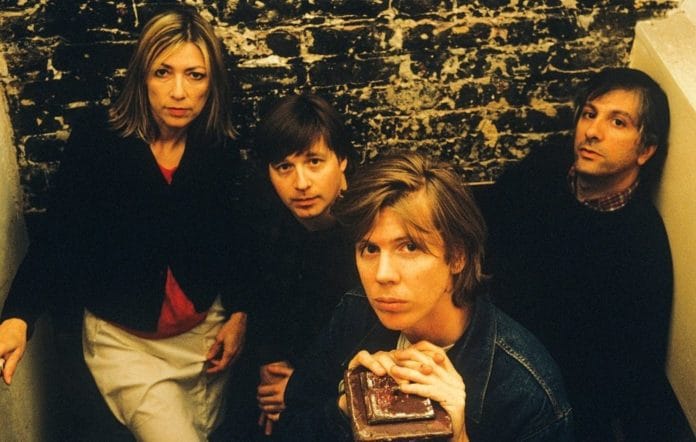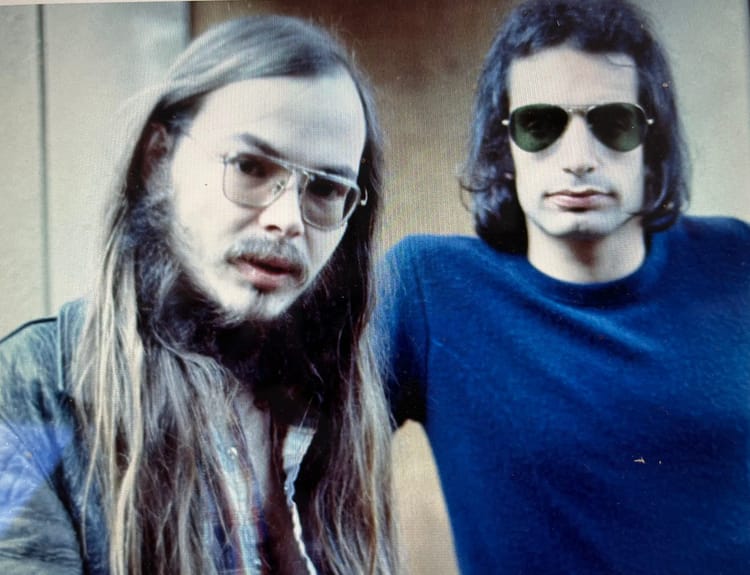Sonic Youth, pt. 2: Anthony's Album Guide

Part 1 is here. Part 3 is here. My handy-dandy super-subjective rating scale is explained here.
Experimental Jet Set Trash And No Star (1994) 5
Made In USA (1995) 5
Screaming Fields Of Sonic Love (1995) 6
Washing Machine (1995) 8
SYR1 EP (1997) 6
SYR2 EP (1997) 4
SYR3 (1998) 8
A Thousand Leaves (1998) 8
Silver Session For Jason Knuth EP (1998) 5
SYR4: Goodbye 20th Century (1999) 3
NYC Ghosts & Flowers (2000) 4
Cool New York No Wave veterans they were, Sonic Youth was well over grunge by 1994. The band followed Dirty’s dalliance with afternoon MTV and mall t-shirt stores by touring with rising indie acts like Pavement and Sebadoh, determined to stay hip as Nirvana begat Pearl Jam begat Stone Temple Pilots on the radio. Though Nevermind-er Butch Vig remained in the producer’s seat, Experimental Jet Set Trash And No Star, recorded before and released a month after Kurt Cobain’s death, undercut the band’s whallop and wedged blurts of noise inside of short, sharp tunelets, a la Beck and the Breeders. With the album debuting in the Top 50, and Bikini Kill’s Kathleen Hanna dancing in the “Bull In The Heather” video, the band looked primed for the impending alternapop era.
“Bull In The Heather,” bringing in a ringer.
The problem wasn't what you saw, though, but what you heard. “Heather” failed to break through, possibly because Kim Gordon’s wan panting was outshined by Steve Shelley’s drum break. The bassist’s vocals had only grown more constipated since Dirty, already a joyless parody of butt-rock on that album. Meanwhile, husband Thurston Moore’s ironic swagger (especially with the benefit of hindsight) had turned into creepy concern trolling, objectifying riot grrrls and it-girls on “Self-Obsessed and Sexxee” and “Waist.” Guitarist Lee Ranaldo, feeling his third banana status, stuck to sound-effects. “Screaming Skull” is a fun tribute to punk commerce at the SST Superstore, and Moore de-centers himself enough on “Androgynous Mind” to convey confusion and horror more than leering paternalism. But Jet Set was Sonic Youth’s thinnest album to date, perversely catching them at their most pop and least fun.
At the time, only the most fickle fans and radio programmers held Jet Set’s failure against them. DGC re-released all their ‘80s albums on CD with bonus tracks, as well as a fine-enough compilation of the era (the video collection on VHS was more worthwhile). Rhino released a slight soundtrack to a forgotten movie from 1986 that sounds oddly like anonymous indie jangle when it doesn’t sound like Sonic Youth leftovers. Thurston released a solo album with Steve on drums. Kim’s indie supergroup Free Kitten put out an album. Lee put out a compilation of noises he recorded in the ’80s. They also toured like the dickens in 1995, first opening for R.E.M.’s return to arenas, then headlining that summer’s Lollapalooza tour above Beck, Pavement, Hole and The Mighty Mighty Bosstones. Thurston and Kim also had a kid, underscoring their scene elder status (Lee had already achieved this milestone in the ‘80s).
The radio edit of the road epic.
Counterintuitively, the group released Washing Machine a month after Lollapalooza ended, despite several tracks from the album regularly appearing in their festival setlist. Vocal affectations remain a weak spot, with Gordon emulating little trouble girls (though with atypical energy on “Panty Lies”) and Moore blowing them kisses (though with atypical beauty on “Unwind”). But musically, Machine is as loose as Jet Set was tight, filling the stadium with guitar interplay (Gordon often trading her bass for one) rather than shrinking itself for radio. Ranaldo takes the mic twice, his amiable beat persona a nice break from the power couple’s familiar gestalt. The nine-minute title track would be their longest song ever if it wasn’t topped by nearly 20 minutes of “The Diamond Sea,” where the band finally embraces beauty for beauty’s sake, updating “Marquee Moon” with howling torrents of feedback for the alterna-era they helped usher in.
As indie rock became more upscale, and less optimistic about pop crossover, so did Sonic Youth. In 1997, now owning their own studio in Manhattan (Lollapalooza, baby!), the band launched the SYR label for instrumental and experimental releases apparently too heady for DGC/Geffen. SYR3 (liners in Esperanto), a collaboration with Chicago indie artiste Jim O’Rourke, is the most fulfilling of the initial releases, with the band creating some genuinely novel sounds and jazz-like crescendos. The one vocal is regrettable, but putting one regrettable vocal on an instrumental album is jazz-like, too. SYR2 (liners in German) is flagrantly work tapes for the next DGC album. SYR1 (liners in French) could be leftovers from the last one. Few heard SYR3 at the time, probably because they were looking at the price sticker and muttering “you won’t fool me three times, motherfuckers.”
Almost forgot. Between Lollapalooza and the SYR EPs, Sonic Youth did The Simpsons.
1998’s A Thousand Leaves opens with four minutes of Gordon avoiding melody in sing-song (“it’s just a kitten!”) over noises negligible enough for an SYR release. Blessedly, “Contre Le Sexisme” (oh boy) is the only time the band’s explorations fail to cohere into a song. That one sure didn’t need to be four minutes, and not all that followed needed to be even longer. But Moore’s “Sunday” and Ranaldo’s “Karen Koltrane” are melodic career highlights with merciless kraut-rock climaxes (also on the latter? Harmonies!). Gordon‘s “The Ineffable Me“ might be her strongest showing since “Kool Thing,” if not “The Sprawl.” Sometimes I think Leaves, so unapologetically autumnal and avant-minded, needs to be even longer to justify its cult; Sonic Youth already has a classic double, so this should be their Sandinista! Mostly, I just wish they’d cut “Sexisme” and “Hits Of Sunshine,” eleven minutes of Thurston threatening to become Trey Anastasio.
It’s important to remember that streaming was not yet an option for the obscurity-curious at this time, and that the underground was flowering with countless EPs and side-projects from prolific “post-rock” combos. At the same time, the internet was allowing cranks like the ones at young Pitchfork to decry unrewarding purchases. Sonic Youth, ‘80s indie legends turned ‘90s not-big-things, was now too weird for radio but too familiar to be forgiven indulgence. I saw the band headline Penn State’s annual Movin’ On Festival in 1998, where they played the entirety of A Thousand Leaves - not yet released - and nothing else. The hippies who barely knew them loved it because it was trippy. The jocks who barely knew them loved it because it was loud. I had a promo of Leaves and loved it. The people who didn’t love it? Sonic Youth fans, who hoped they’d at least hear “The Diamond Sea,” if not “Teen Age Riot.”
Harmony Korine’s “Sunday” video, the real Home Alone 3.
As the decade punk broke came to an end (with punk now meaning Blink-182), the minds of Sonic Youth fans continued to be more annoyed than blown by the band. Two months after the release of Leaves, the band released a half-hour of feedback drones (albeit, for charity). A year later came SYR4: Goodbye 20th Century, a double record of the band “covering” avant-classical compositions by John Cage and the like. Seventeen seconds of five-year-old Coco Moore screaming was called a Yoko Ono cover. *snaps fingers repeatedly, thanks Satan that streaming exists today.* Many Thrill Jockey fans with growing jazz and techno collections were not impressed. Anyone holding a candle for “alternative rock” definitely wasn’t.
Sonic Youth’s gear was stolen on the road in 1999, either by a cynical alternative rocker or by someone who hoped they’d go in bold new directions. On 2000's NYC Ghosts & Flowers, the band did not. While I can’t say it deserves the 0.0 teabagging Pitchfork gave it, I understand that youthful outrage more than the professionals who acclaimed the album as impressively experimental. The guitars are still recognizable as late ‘90s Sonic Youth, the vocals are still recognizable as late ‘90s Sonic Youth. There’s a little more electronic “noise” (a cheap commodity in 2000), and the guys did more spoken-word (I’m not even sure that qualifies as a commodity). But the album is shockingly listless compared to Leaves. “Renegade Princess” peters out like Moore realized it was self-parody mid-recording. Everyone seems to know Ranaldo’s title track is self-parody except him. Gordon’s “Lightnin” confirms she’d long accepted self-parody as a viable artistic avenue. Goodbye 20th century, indeed.
So many cool friends, so little song.
Geffen - now merged with Interscope - included an interview with the band in the last promo VHS I ever spotted at my college radio station. Watching these guys do their aloof, smirky shtick at some wide-eyed millennial label lackey half their age, Lee grabbing the camera to film himself in the mirror sideways or some shit, well…I’m not the one that wrote “Kill Yr. Idols.”
In part 3: Surprisingly, Sonic Youth survives - nay, thrives! Until they don't.
None of the above make my Top 300 Albums of All Time, but you can spoil pt 3 by checking it out. I'm telling you this because I've found people are more inclined to discuss and share reviews if there's a quantitative element at the top or bottom they can easily debate. Prove me right! Direct correspondence can be shipped off to anthonyisright at gmail dot com.




